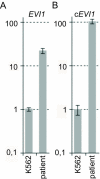EVI1 activation in blast crisis CML due to juxtaposition to the rare 17q22 partner region as part of a 4-way variant translocation t(9;22)
- PMID: 18613965
- PMCID: PMC2474635
- DOI: 10.1186/1471-2407-8-193
EVI1 activation in blast crisis CML due to juxtaposition to the rare 17q22 partner region as part of a 4-way variant translocation t(9;22)
Abstract
Background: Variant translocations t(9;22) occur in 5 to 10% of newly diagnosed CMLs and additional genetic changes are present in 60-80% of patients in blast crisis (BC). Here, we report on a CML patient in blast crisis presenting with a four-way variant t(9;22) rearrangement involving the EVI1 locus.
Methods: Dual-colour Fluorescence In Situ Hybridisation was performed to unravel the different cytogenetic aberrations. Expression levels of EVI1 and BCR/ABL1 were investigated using real-time quantitative RT-PCR.
Results: In this paper we identified a patient with a complex 4-way t(3;9;17;22) which, in addition to BCR/ABL1 gene fusion, also resulted in EVI1 rearrangement and overexpression.
Conclusion: This report illustrates how a variant t(9;22) translocation can specifically target a second oncogene most likely contributing to the more aggressive phenotype of the disease. Molecular analysis of such variants is thus warranted to understand the phenotypic consequences and to open the way for combined molecular therapies in order to tackle the secondary oncogenic effect which is unresponsive to imatinib treatment.
Figures




References
-
- Ogawa S, Kurokawa M, Tanaka T, Tanaka K, Hangaishi A, Mitani K, Kamada N, Yazaki Y, Hirai H. Increased Evi-1 expression is frequently observed in blastic crisis of chronic myelocytic leukemia. Leukemia. 1996;10:788–794. - PubMed
-
- Lugthart S, Drunen EV, Norden YV, Hoven AV, Erpelinck CA, Valk PJ, Beverloo HB, Lowenberg B, Delwel R. High EVI1 levels predict adverse outcome in acute myeloid leukemia: prevalence of EVI1 overexpression and chromosome 3q26 abnormalities underestimated. Blood. 2008 - PubMed
Publication types
MeSH terms
Substances
LinkOut - more resources
Full Text Sources
Medical
Research Materials
Miscellaneous

